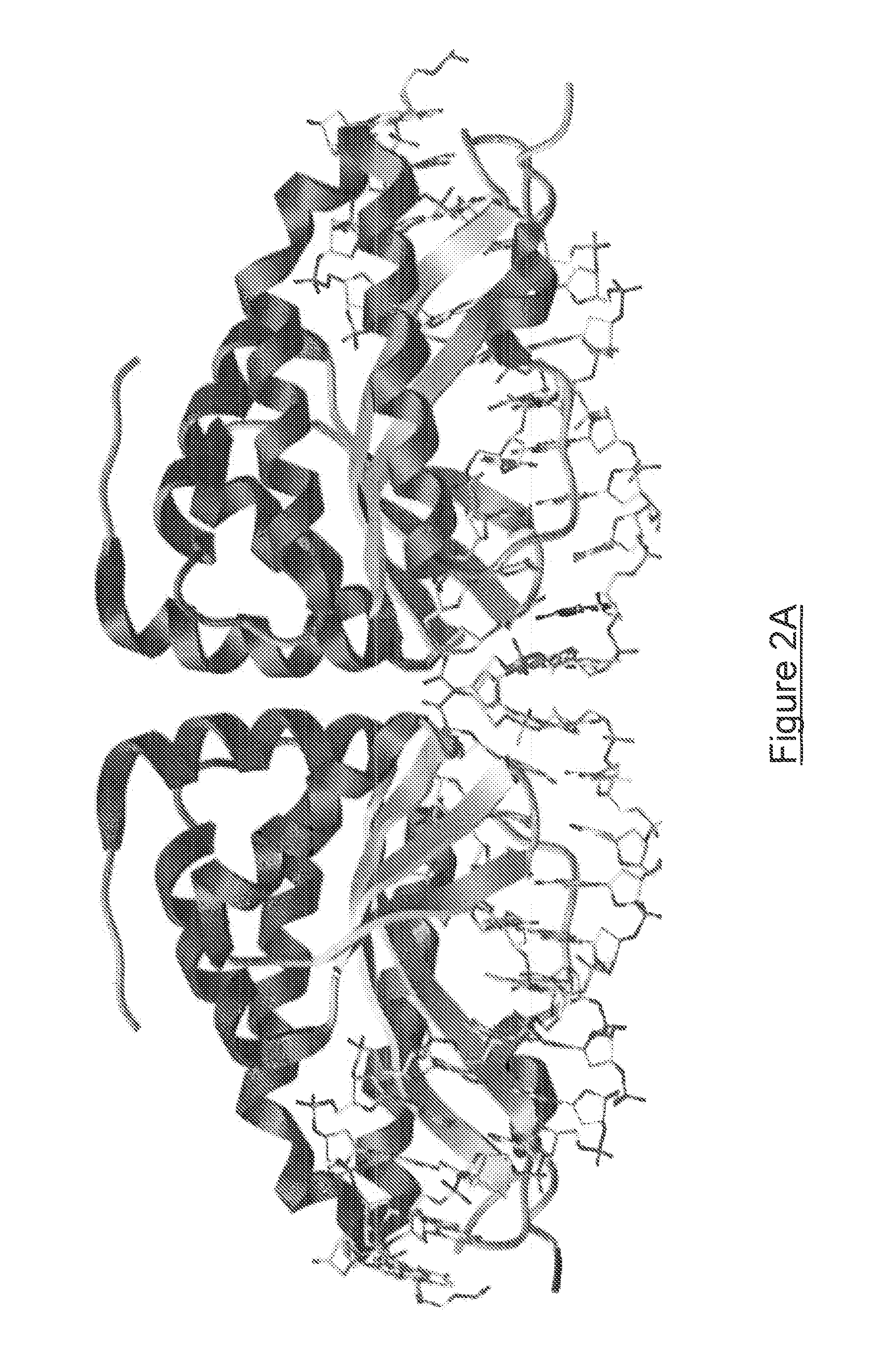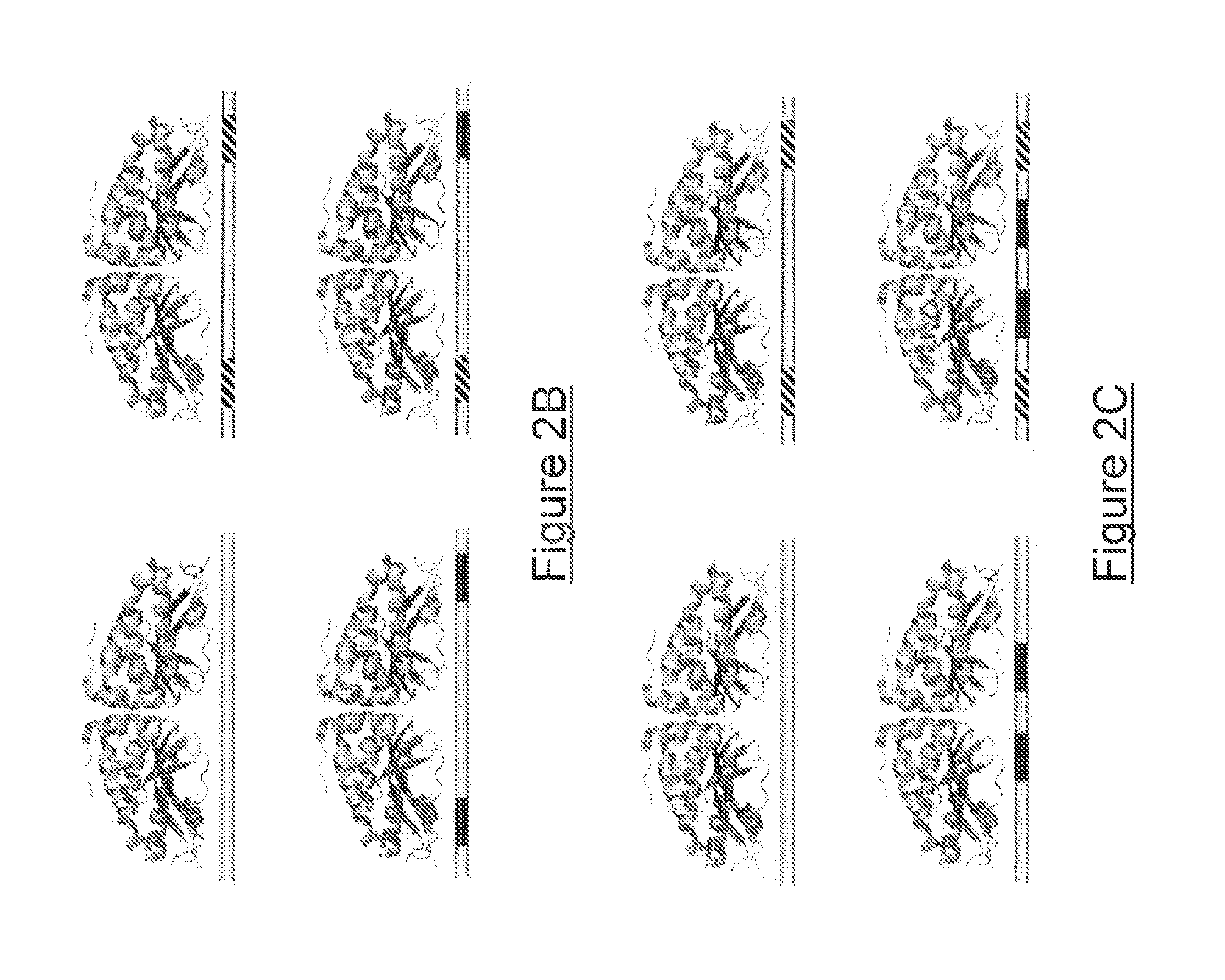Meganuclease variants cleaving a DNA target sequence from the dystrophin gene and uses thereof
a technology of dna target sequence and meganuclease, which is applied in the field of meganuclease variants, can solve the problems of not alleviating all the possible risks, dmd is much more difficult to imagine, and the precision comes
- Summary
- Abstract
- Description
- Claims
- Application Information
AI Technical Summary
Benefits of technology
Problems solved by technology
Method used
Image
Examples
example 1
Engineering Meganucleases Targeting the DMD21 Locus
[0287]a) Construction of Variants Targeting the DMD21 Locus
[0288]DMD21 is an example of a target for which meganuclease variants have been generated. The DMD21 target sequence (GA-AAC-CT-CAA-GTAC-CAA-AT-GTA-AA, SEQ ID NO: 4) is located at positions 993350-993373 in 3′ of exon 38 of DMD gene, within intron 38.
[0289]The DMD21 sequence is partially a combination of the 10AAC_P (SEQ ID NO: 5), 5CAA_P (SEQ ID NO: 6), 10TAC_P (SEQ ID NO: 7) and 5TTG_P (SEQ ID NO: 8) target sequences which are shown on FIG. 4. These sequences are cleaved by mega-nucleases obtained as described in International PCT applications WO 2006 / 097784 and WO 2006 / 097853, Arnould et al. (J. Mol. Biol., 2006, 355, 443-458) and Smith et al. (Nucleic Acids Res., 2006).
[0290]Two palindromic targets, DMD21.3 and DMD21.4, were derived from DMD21 (FIG. 4). Since DMD21.3 and DMD21.4 are palindromic, they are be cleaved by homodimeric proteins. Therefore, homodimeric I-CreI v...
example 2
Engineering Meganucleases Targeting the DMD24 Locus
[0295]a) Construction of Variants Targeting the DMD24 Locus
[0296]DMD24 is an example of a target for which meganuclease variants have been generated. The DMD24 target sequence (TT-TAC-CT-ATT-TTAA-GTC-AG-ATA-CA, SEQ ID NO: 11) is located at positions 995930-995953 in 3′ of exon 39 of DMD gene, within intron 39.
[0297]The DMD24 sequence is partially a combination of the 10TAC_P (SEQ ID NO: 12), 5ATT_P (SEQ ID NO: 13), 10TAT_P (SEQ ID NO: 14) and 5GAC_P (SEQ ID NO: 15) target sequences which are shown on FIG. 6. These sequences are cleaved by mega-nucleases obtained as described in International PCT applications WO 2006 / 097784 and WO 2006 / 097853, Arnould et al. (J. Mol. Biol., 2006, 355, 443-458) and Smith et al. (Nucleic Acids Res., 2006).
[0298]Two palindromic targets, DMD24.3 and DMD24.4, and two pseudo palindromic targets, DMD24.5 and DMD24.6, were derived from DMD24 and DMD24.2 (FIG. 6). Since DMD24.3 and DMD24.4 are palindromic, th...
example 3
Engineering Meganucleases Targeting the DMD31 Locus
[0303]a) Construction of Variants Targeting the DMD31 Locus
[0304]DMD31 is an example of a target for which meganuclease variants have been generated. The DMD31 target sequence (AA-TGT-CT-GAT-GTTC-AAT-GT-GTT-GA, SEQ ID NO: 21) is located at positions 1125314-1125337 in 3′ of exon 44 of DMD gene, within intron 44.
[0305]The DMD31 sequence is partially a combination of the 10 TGT_P (SEQ ID NO: 22), 5 GAT_P (SEQ ID NO: 23), 10 AAC_P (SEQ ID NO: 24) and 5 ATT_P (SEQ ID NO: 25) target sequences which are shown on FIG. 8. These sequences are cleaved by mega-nucleases obtained as described in International PCT applications WO 2006 / 097784 and WO 2006 / 097853, Arnould et al. (J. Mol. Biol., 2006, 355, 443-458) and Smith et al. (Nucleic Acids Res., 2006).
[0306]Two palindromic targets, DMD31.3 and DMD31.4, and two pseudo palindromic targets, DMD31.5 and DMD31.6, were derived from DMD31 and DMD31.2 (FIG. 8). Since DMD31.3 and DMD31.4 are palindrom...
PUM
| Property | Measurement | Unit |
|---|---|---|
| Volume | aaaaa | aaaaa |
| Volume | aaaaa | aaaaa |
| Fraction | aaaaa | aaaaa |
Abstract
Description
Claims
Application Information
 Login to View More
Login to View More - R&D
- Intellectual Property
- Life Sciences
- Materials
- Tech Scout
- Unparalleled Data Quality
- Higher Quality Content
- 60% Fewer Hallucinations
Browse by: Latest US Patents, China's latest patents, Technical Efficacy Thesaurus, Application Domain, Technology Topic, Popular Technical Reports.
© 2025 PatSnap. All rights reserved.Legal|Privacy policy|Modern Slavery Act Transparency Statement|Sitemap|About US| Contact US: help@patsnap.com



